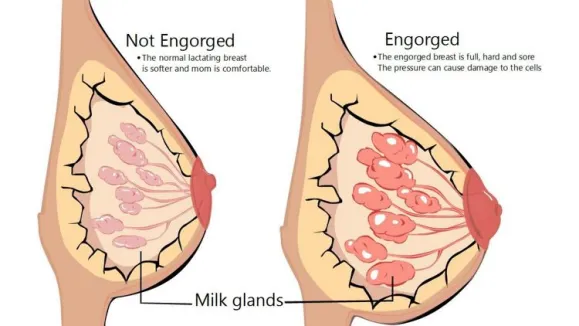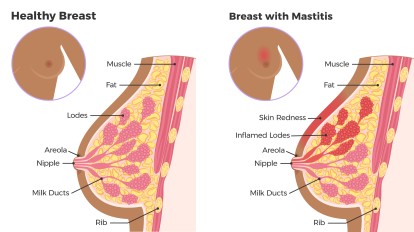If you ask a breast/chestfeeding parent which is better, oversupply or low supply, they will likely say oversupply. The truth is, neither is ideal. You should have the amount of milk your baby needs. I have seen my share of oversupply issues in the last few months. How do you know if you have too much breastmilk? Let’s talk about the problems surrounding having too much milk, and how to manage it.
Having too much milk sounds like a good problem to have, doesn’t it? However, there are many issues that can go along with oversupply.
Discomfort And Engorgement
The parents I talk to who are trying to manage an overabundance of milk are always full and uncomfortable. They may experience engorgement if the baby sleeps a little longer overnight or leak constantly throughout the day. They have that feeling of always being full, even after the baby eats. I was talking with a new parent this week who is dealing with oversupply. She was frustrated with how messy the feedings are, and how she wakes up in a pool of milk. There are ways to help stay comfortable when dealing with engorgement, and you can read more about that here.

Plugged Milk Ducts
Plugged milk ducts are literally a pain. They are uncomfortable to deal with, and parents are so frustrated with them. There are several reasons for why they happen, and one of them is oversupply. There is just too much milk, and your baby is not able to drain the breast, leaving milk behind. If you have a plug, you may feel a hard lump in the breast where it is obstructing milk flow. It may be painful or tender. Continue to feed on that breast and use ibuprofen and ice to help with inflammation. Here is some more helpful information about plugged milk ducts and how to manage them.
Mastitis
Mastitis is a breast infection. It causes flu-like symptoms, and breastfeeding may be uncomfortable. Plugged milk ducts can cause mastitis, as the plug prevents milk from flowing. If the infection is bad enough, you may need to call your doctor for antibiotics to help treat it. Mastitis can also be caused by infection (cracked nipples can be a point of entry for bacteria). If you experience mastitis, a visit with a lactation consultant is helpful to make sure the baby’s latch is good and feeds are efficient. Here is more information on how to manage mastitis, and when you may need to call your doctor.

Discomfort For Baby
A parent who is experiencing an oversupply of milk may have a very uncomfortable baby. A baby who is overeating because of oversupply may have more gas and reflux type symptoms. Imagine how you feel when you overeat. Babies aren’t much different. A parent with oversupply will often see more spitting up with their baby as well. It’s not uncommon for a parent to be unaware of their oversupply until they start seeing more spitting up and discomfort with their baby. It’s usually at this point I will hear from parents, and we can determine if oversupply is the root cause of the issue.
Oversupply of milk can also lead to a strong milk letdown, which can be difficult for some babies to handle. If the milk is flowing too quickly for them, your baby may cough, choke, or pull off the breast when the milk lets down. You may need to readjust your baby’s feeding position or take the baby off the breast/chest when the letdown happens so it’s easier for them to manage. Here are some other tricks you can try to help manage a fast or forceful letdown.

Allergy Or Oversupply?
Oversupply is often misdiagnosed as an allergy or intolerance for babies. This is because oversupply can lead to discomfort and digestive issues such as spitting up, gas and reflux. Breast/chestfeeding parents who are dealing with digestive issues with their baby will often be directed to limit certain foods from their diet. Particularly dairy or soy. Since it is a common oversupply issue, it can be managed without the parent limiting any foods at all.
Reasons For Oversupply
So how does a breast/chestfeeding parent end up with oversupply, anyway? There are a couple of reasons for oversupply, but the most common reason I see is pumping. Don’t get me wrong – I am aware pumping is a necessity for many parents, especially when preparing to return to work. That’s not the kind of pumping I am referring to.
Pumping
Milk supply is strongly established in the first 2 weeks. During these weeks, feeding the baby is giving your body the message of how much milk the baby needs. The relationship between the feeding baby and the parent is strong, and your body starts to regulate milk supply based on this. It can work both ways. If a parent is not putting the baby to the breast/chest enough, milk supply may suffer. If a parent is feeding on demand and pumping in the first two weeks while supply is being established, the message is clear. Too much milk. Your body will think there are multiple babies to feed. If you don’t have multiple babies, this can be problematic.
I see many parents pumping as soon as they leave the hospital, or within the first week of the baby being born. If the baby is feeding well, and feeding on demand, leave the pump alone. Oversupply can be difficult to manage once it starts. If you are having trouble with feeds, or if the baby is not latching or gaining weight accordingly, you may need to pump. Definitely make sure you are working with a lactation consultant under these circumstances.
To be honest, pumping is just one more thing to do. If your baby is feeding well, just keep feeding your baby on demand. This will enable you to naturally establish a healthy milk supply based on your baby’s needs. You will be able to safely pump as your supply regulates.

Hormones
Oversupply can also be caused by hormonal issues. Because breastfeeding is largely hormonal, a hormone imbalance can lead to an overabundance of breastmilk. A simple blood test to check thyroid and prolactin levels can be very helpful in determining if this is the cause of oversupply. Increased prolactin levels could be related to many different problems or medications. You can learn more about that here.
If you are experiencing oversupply, there are a couple of things you can do to help.
Stop Pumping
If you are pumping, consider either decreasing how frequently you are pumping or stop pumping altogether. It doesn’t have to be forever, just until your supply is managed. There are safe ways to include pumping into your breast/chestfeeding relationship. It is important to work with a lactation consultant when figuring all of this out.
Feeding Positions
Consider feeding your baby in a reclined or side-lying position. This helps because your milk will naturally slow down when in a reclined or lying position (thank you gravity). Your baby will be much more comfortable during the feed if you can slow down that milk flow.

Adjust The Feeds
Allowing your baby to feed on only one breast per feeding will signal your body to slow down supply. When babies are newborns, it is common to have a baby feeding on both breasts per feed. As they grow, they may not need to feed on both breasts every feeding. Don’t time your feedings. Let your baby stay on one breast as long as they want. This will help them to drain one breast, and your supply will have a greater chance of regulating to what your baby needs, instead of having too much.
Keep in mind that your milk supply will also adjust as time passes. Parents struggling with oversupply often find they are more comfortable after about 3 or 4 months. However, anything you can do to help regulate oversupply early is considerably helpful. As with any issue you may face during your breastfeeding relationship, don’t hesitate to reach out to a lactation consultant. They can help you navigate these tricky areas with ease!





